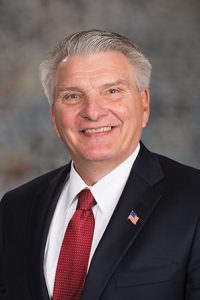Tax incentive for workforce housing construction advanced
Certain cities could use tax increment financing to support the construction of workforce housing under a bill advanced by lawmakers April 10.
As introduced by Gering Sen. John Stinner last session, LB496 would authorize cities of the first and second class and villages to include the construction of single-family or multi-family housing as part of a redevelopment project eligible for TIF.
Stinner said that demand for such homes is high in rural communities across the state, from Scottsbluff to Kearney to Norfolk. Allowing TIF to be used for construction of those homes would make them more affordable, he said.
The bill would require a municipality to conduct a housing study, prepare an incentive plan for the construction of housing meant for new or existing workers and hold a public hearing on the plan. As amended, a public hearing on a workforce housing incentive plan would be separate from a public hearing on a TIF redevelopment plan.
After the hearing, the municipality would be required to determine that the plan is necessary to prevent the spread of blight and substandard conditions within the municipality, will promote additional safe and suitable housing for people employed there and will not result in the unjust enrichment of any individual or company.
Sen. Matt Williams of Gothenburg introduced an amendment, adopted 34-6, that would restrict the bill’s provisions to rural communities, which the amendment defines as any municipality in a county with fewer than 100,000 inhabitants.
The amendment also would define workforce housing as owner-occupied housing units that cost no more than $275,000 to build or rental housing units that cost no more than $200,000 to build.
Williams, who supported the bill, said those criteria are consistent with LB518, passed by the Legislature last year, which set aside $7 million to provide matching grants to nonprofits to build workforce housing in rural communities. He said the program began in January and already has stopped accepting applications because of high demand.
“Twenty-one communities submitted grant applications for more than double the amount of dollars that we have in the program,” Williams said, “showing clearly that there is a demonstrated need for rural workforce housing.”
Omaha Sen. Justin Wayne introduced an amendment, adopted 39-1, that would allow the use of TIF to finance workforce housing in areas with high unemployment and poverty rates within cities.
“The issue in some small towns across Nebraska are no different than many issues that we face in North Omaha when it comes to housing,” he said. “There is a gap that we have to fill.”
Sen. Mike Groene of North Platte opposed the bill. He said TIF was conceived to help cities redevelop blighted and substandard areas, not to boost economic development. Using TIF for housing construction would divert property tax revenue away from schools and other local government entities and distort the housing market, he said.
“Do you believe in the free markets at all?” Groene said. “If there is demand for housing, it is being built.”
Also in opposition was Columbus Sen. Paul Schumacher. If a city allows one developer to use TIF, all of its competitors will want it too, he said, and cities that choose not to grant TIF for single-family housing projects will lose those projects to cities that do.
“If you start this intercommunity war,” Schumacher said, “you will never have any number of houses built without TIF.”
Sen. Curt Friesen of Henderson also opposed the bill. He said he supports the use of TIF to build infrastructure—such as streets, sewer systems and water systems—that supports private development, but he opposes its use for building houses.
“If we would focus on bringing more jobs—better paying jobs—to the state and to the rural areas,” he said, “we wouldn’t have to worry about subsidizing housing.”
Stinner filed a motion to invoke cloture, or cease debate and vote on the bill. The motion succeeded on a vote of 33-11. Thirty-three votes were needed.
Senators then voted 34-6 to advance the bill to final reading.

